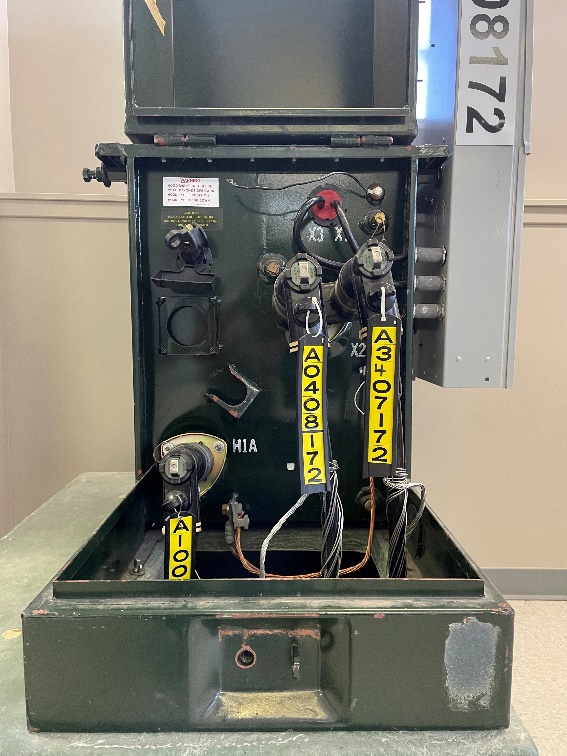14 Topic: Underground Transformers (15m)
Instructions:
- Cover the following content as a group (either reading out loud or independently) then give an opportunity to answer any questions.
- Have students do the review questions independently, then take up answers.

Transformers must be square, level and at the proper grade. They must sit on the appropriate “tub or vault” and be fastened down.
The cable is coiled in the transformer well, so in the event of a termination burning off, a splice will not be necessary to allow the cable to reach the bushings.
The conductor, in a vault, is coiled in opposing direction as follows:
- Primary – clockwise direction to accommodate the primary bushings, which are on the left side of the transformer.
- Secondary – counter-clockwise direction to accommodate the primary side bushings, which are on the right side of the transformer.
The incoming line primary cable should always be installed on the H1A bushing, with the exiting (load) cable coming off the H1B.
These cables should always be labeled properly with cable markers. The cables are marked by showing the location of the apparatus attached to the opposite end of that cable.

Conductor should never be energized until it is properly terminated in the pedestals or transformers, and all workers have given clearance. The cable should be meggered to ensure it is insulated from any reference to ground. Meggering will also ensure cables are not cross-phased.

All underground cable and apparatus is subject to clearance standards. (See Section C-26-02 in the Underground Construction Standards.) Positioning this equipment without proper clearance may cause interference or hazards.
Review Questions: Transformers (15m)
- ( True / False ) Transformers must be square, level and at the proper grade.
- ( True / False ) Excess cable is not required when constructing an underground transformer structure.
- ( True / False ) Conductor should never be energized until it is properly terminated in the pedestals or transformers, and all workers have given clearance.
- ( True / False ) Primary cables are placed in a counter-clockwise direction to accommodate the primary side bushings, which are on the right side of the transformer.
- ( True / False ) Primary cables are placed in a clockwise direction to accommodate the primary bushings, which are on the left side of the transformer.
Answer Key
- T
- F
- T
- F
- T
Final Test
1. Insulators are rated at ( 1/4, 1/2, 1/8 ) their dry flashover voltage
2. ( True / False ) Insulators can be made of porcelain glass or epoxy.
3. ( True / False ) Suspension insulators should never have insulators added to increase the insulation rating.
4. Match the statements on the right with the insulators on the left.
|
a) Copper |
____ It has a very high resistance |
|
b) ACSR |
____ This is a coated steel conductor |
|
c) Steel |
____ It is an excellent conductor |
|
d) Copperweld |
____ Long spans and good conductor |
|
e) Aluminum |
____ A low tensile strength limits it to short spans |
5. ( True / False ) A steel core is used on secondary neutrals to support the coated conductors.
6. ( True / False ) Conductor tension must not be exceeded, or conductor damage can occur.
7. What are some physical components of a transformer (circle all that apply)?
- A core
- Conductor winding
- A casing
- Coolant
8. ( True / False ) There is a conductor carrying current from one core to another in a transformer.
9. Pole mount transformers are generally cooled with:
- Forced air
- Standing Air
- Water
- PCB’s
- Oil
10. ( True / False ) Reclosers clear permanent faults.
11. ( True / False ) Reclosers isolate temporary faults.
12. ( True / False ) Animals can cause an OCR to operate.
13. ( True / False ) Switches are designed to be used only once.
14. ( True / False ) A loadbreak cut out is one type of switch.
15. ( True / False ) A G.O.P.T is one type of switch.
16. Line to line volts can refer to the voltage:
- Between phases
- Phase to ground
- Phase to neutral
- None of the above
17. ( True / False ) line to line voltage is a phase-to-phase voltage.
18. A single-phase line can only supply:
- Line to line voltage
- Phase to phase voltage
- Line to ground voltage
- None of the above
19. Secondary lines are rated to their:
- Line to ground voltage
- Line to line voltage
- Supply voltages
- All of the above
20. A bolt hole is drilled ( 1/16 or 1/8 or 1/4 ) inch larger than the bolt to be used
21. On severe deflections, poles may split if:
- Double timbers are not used
- Copper conductor is used
- Ant-split bolts are not used
- All of the above
22. ( True / False ) Danger signs are necessary on all poles which have equipment accessible from ground level.
23. On poles with cut-outs, the ground wire is located:
- Opposite the back
- Away from personnel operating the cut-out with a hotstick
- Opposite the belly
- None of the above
24. List the last two checks which are done before a customer is supplied power.
25. List the six main parts of a pole:
26. The back of a pole is:
- Also known as the face
- Is the weakest side structurally
- Is opposite the gain
- All of the above
27. The ( belly / back / gain ) side of a pole is opposite the gain side.
28. The job at hand requires you to rig a 50kVA transformer using two 1-metre slings. The transformer weighs 350 kg. The slings must be rigged so the tension does not exceed 200 kg per sling.
a)What must the angle be where each sling meets the transformer?
b)What would the tension on each sling be if the above angle was decreased to 15 degrees?
29. ( True / False ) Take-Off structures are never fused.
30. ( True / False ) Non load break cutouts are used on take-off structures.
31. ( True / False ) Pedestals transform voltage from 14.4 kV to 120/240 V.
32. ( True / False ) The voltage that is supplied to the pedestal is the same as the voltage leaving the pedestal.
33. ( True / False ) Transformers must be square, level and at the proper grade.
34. ( True / False ) Excess cable is not required when constructing an underground transformer structure.
35. ( True / False ) Conductor should never be energized until it is properly terminated in the pedestals or transformers, and all workers have given clearance.
Final Test Answers
1. (1/8) 2. (T) 3. (F) 4. (c, d, a, b, e) 5. (T) 6. (T) 7. (a, b, c, d) 8. (F) 9. (e) 10. (F) 11. (F) 12. (T) 13. (F) 14. (T) 15. (T) 16. (a) 17. (T) 18. (C) 19. (A) 20. (1/16) 21. (C) 22. (T) 23. (B) 24. (Voltage, Phase Rotation) 25. (snipe, butt, belly, back (face), gain, stamp) 26. (A) 27. (belly) 28. (61 degrees, b. 676 kg) 29. (F) 30. (F) 31. (F) 32. (T) 33. (T) 34. (F) 35. (T)
